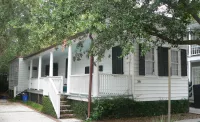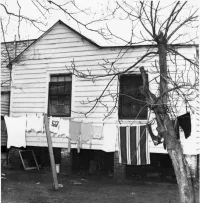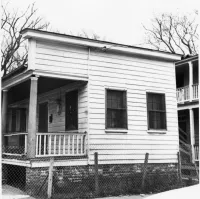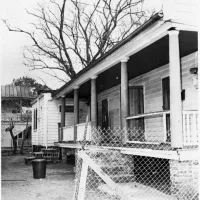Share what you know,
and discover more.
Share what you know,
and discover more.
Sep 14, 2011

-

- Charmaine Bantugan
Denmark Vesey House
Commonly known as the Denmark Vesey House, the house located at 56 Bull Street in Charleston, South Carolina was for a long time thought to be the house once inhabited by black abolitionist Denmark Vesey. Vesey's home, listed as 20 Bull Street under the city's former numbering system, is now evidently gone. A nearby home, most likely built in the 1820 and currently numbered 56 Bull Street, was thought in the 1970s to have been the home of Denmark Vesey, and it was designated as a National Historic Landmark in 1976 by the Department of Interior. The house described as the Vesey house is a single story wood-frame structure, oriented sideways to the street. The narrow street facade has two windows, while the longer west side has a porch extending across the front portion, with a wider addition to the back. Two doors enter the house from the porch. The interior of the front portion has three rooms, one beside the other, and the rear addition has four more.
Denmark Vesey House
Commonly known as the Denmark Vesey House, the house located at 56 Bull Street in Charleston, South Carolina was for a long time thought to be the house once inhabited by black abolitionist Denmark Vesey. Vesey's home, listed as 20 Bull Street under the city's former numbering system, is now evidently gone. A nearby home, most likely built in the 1820 and currently numbered 56 Bull Street, was thought in the 1970s to have been the home of Denmark Vesey, and it was designated as a National Historic Landmark in 1976 by the Department of Interior. The house described as the Vesey house is a single story wood-frame structure, oriented sideways to the street. The narrow street facade has two windows, while the longer west side has a porch extending across the front portion, with a wider addition to the back. Two doors enter the house from the porch. The interior of the front portion has three rooms, one beside the other, and the rear addition has four more.
Sep 14, 2011
Denmark Vesey House
Commonly known as the Denmark Vesey House, the house located at 56 Bull Street in Charleston, South Carolina was for a long time thought to be the house once inhabited by black abolitionist Denmark Vesey. Vesey's home, listed as 20 Bull Street under the city's former numbering system, is now evidently gone. A nearby home, most likely built in the 1820 and currently numbered 56 Bull Street, was thought in the 1970s to have been the home of Denmark Vesey, and it was designated as a National Historic Landmark in 1976 by the Department of Interior.The house described as the Vesey house is a single story wood-frame structure, oriented sideways to the street. The narrow street facade has two windows, while the longer west side has a porch extending across the front portion, with a wider addition to the back. Two doors enter the house from the porch. The interior of the front portion has three rooms, one beside the other, and the rear addition has four more.
Posted Date
Oct 14, 2022
Historical Record Date
Sep 14, 2011
Source Name
Wikipedia
Source Website
Delete Story
Are you sure you want to delete this story?
May 11, 1976
May 11, 1976

-

- Charmaine Bantugan
National Register of Historic Places - Denmark Vesey House
Statement of Significance: Many rebellions and rumors of rebellions occurred throughout the South during the slavery period. One of the most alarming insurrections was that planned in 1622 by a free-black man/ Denmark Vesey. Vesey was a trusted member of the free-black population who could read and write. He had been a resident of Santo Domingo, the scene of an earlier rebellion. Vesey designed an insurrection plan of such precision and efficiency that mass hysteria was created throughout the Caroline’s and the South. Little is known of Vesey's early years prior to 1781. However, it seems certain that he was no more than a generation removed from his African heritage, and that he was raised in the Virgin Islands among newly imported Africans whose culture and will to be free remained strong. In 1781, Captain Joseph Vesey, a slaver, arrived at the island of Saint Thomas. He collected 390 slaves including young Denmark. The officers and crew made a "pet" of Denmark and as a result he was brought to the attention of Captain Vesey. The ship left Saint Thomas and landed in Santo Domingo where the cargo of slaves was sold. Captain Vesey took young Denmark back aboard ship as his personal servant. Denmark's extensive travels exposed him to a variety of experiences and languages. He learned to speak Danish, English, French and Spanish, and witnessed the day-to-day cruelties of slavery. He observed the operation and workings of the infamous trade in human chattel and had first-hand knowledge of the indignities suffered by his race in the ship's hold. Denmark viewed the public auction of human beings for approximately fourteen years. As a result of the growing restrictions placed upon the foreign slave trade, Captain Vesey was influenced to leave the trade and settle in Charleston, South Carolina. Denmark remained with the captain until the turn of the century when he won a $1,500 lottery and purchased his freedom for $600. After obtaining his freedom, Denmark took the name of his former master and used the remainder of his funds to establish a carpentry business and residence at 20 Bull Street, Charleston. [Because of several address renumbering plans in the city of Charleston, Vesey's residence of 20 Bull Street in 1822 is today the address being nominated of 56 Bull Street.
National Register of Historic Places - Denmark Vesey House
Statement of Significance: Many rebellions and rumors of rebellions occurred throughout the South during the slavery period. One of the most alarming insurrections was that planned in 1622 by a free-black man/ Denmark Vesey. Vesey was a trusted member of the free-black population who could read and write. He had been a resident of Santo Domingo, the scene of an earlier rebellion. Vesey designed an insurrection plan of such precision and efficiency that mass hysteria was created throughout the Caroline’s and the South. Little is known of Vesey's early years prior to 1781. However, it seems certain that he was no more than a generation removed from his African heritage, and that he was raised in the Virgin Islands among newly imported Africans whose culture and will to be free remained strong. In 1781, Captain Joseph Vesey, a slaver, arrived at the island of Saint Thomas. He collected 390 slaves including young Denmark. The officers and crew made a "pet" of Denmark and as a result he was brought to the attention of Captain Vesey. The ship left Saint Thomas and landed in Santo Domingo where the cargo of slaves was sold. Captain Vesey took young Denmark back aboard ship as his personal servant. Denmark's extensive travels exposed him to a variety of experiences and languages. He learned to speak Danish, English, French and Spanish, and witnessed the day-to-day cruelties of slavery. He observed the operation and workings of the infamous trade in human chattel and had first-hand knowledge of the indignities suffered by his race in the ship's hold. Denmark viewed the public auction of human beings for approximately fourteen years. As a result of the growing restrictions placed upon the foreign slave trade, Captain Vesey was influenced to leave the trade and settle in Charleston, South Carolina. Denmark remained with the captain until the turn of the century when he won a $1,500 lottery and purchased his freedom for $600. After obtaining his freedom, Denmark took the name of his former master and used the remainder of his funds to establish a carpentry business and residence at 20 Bull Street, Charleston. [Because of several address renumbering plans in the city of Charleston, Vesey's residence of 20 Bull Street in 1822 is today the address being nominated of 56 Bull Street.
National Register of Historic Places - Denmark Vesey House
Statement of Significance:Many rebellions and rumors of rebellions occurred throughout the South during the slavery period. One of the most alarming insurrections was that planned in 1622 by a free-black man/ Denmark Vesey. Vesey was a trusted member of the free-black population who could read and write. He had been a resident of Santo Domingo, the scene of an earlier rebellion. Vesey designed an insurrection plan of such precision and efficiency that mass hysteria was created throughout the Caroline’s and the South.
Little is known of Vesey's early years prior to 1781. However, it seems certain that he was no more than a generation removed from his African heritage, and that he was raised in the Virgin Islands among newly imported Africans whose culture and will to be free remained strong.
In 1781, Captain Joseph Vesey, a slaver, arrived at the island of Saint Thomas. He collected 390 slaves including young Denmark. The officers and crew made a "pet" of Denmark and as a result he was brought to the attention of Captain Vesey. The ship left Saint Thomas and landed in Santo Domingo where the cargo of slaves was sold. Captain Vesey took young Denmark back aboard ship as his personal servant.
Denmark's extensive travels exposed him to a variety of experiences and languages. He learned to speak Danish, English, French and Spanish, and witnessed the day-to-day cruelties of slavery. He observed the operation and workings of the infamous trade in human chattel and had first-hand knowledge of the indignities suffered by his race in the ship's hold. Denmark viewed the public auction of human beings for approximately fourteen years.
As a result of the growing restrictions placed upon the foreign slave trade, Captain Vesey was influenced to leave the trade and settle in Charleston, South Carolina. Denmark remained with the captain until the turn of the century when he won a $1,500 lottery and purchased his freedom for $600.
After obtaining his freedom, Denmark took the name of his former master and used the remainder of his funds to establish a carpentry business and residence at 20 Bull Street, Charleston. [Because of several address renumbering plans in the city of Charleston, Vesey's residence of 20 Bull Street in 1822 is today the address being nominated of 56 Bull Street.
Posted Date
Oct 14, 2022
Historical Record Date
May 11, 1976
Source Name
National Register of Historic Places
Source Website
Delete Story
Are you sure you want to delete this story?












